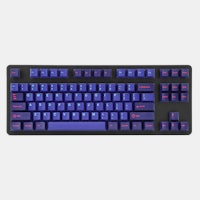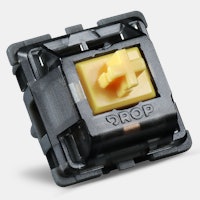Click to view our Accessibility Statement or contact us with accessibility-related questions














Build materials and other case design considerations

search
close
Sort by: Newest
keyboard_arrow_down
Dunn.Ringill
7
Nov 15, 2022
Sorry for the multiple comments. My only issue is me having a hard time finding boards that utilize the 108 key configuration. I'm just a LOT more comfortable with that then the smaller boards.

HoffmanMyster
3277
Community
Nov 15, 2022
Dunn.RingillThat is probably the biggest downside to the hobbyist side of things. There isn't a ton of support for fullsize boards. Have you tried an 1800 layout?

Dunn.Ringill
7
Nov 16, 2022
HoffmanMysterThank you. I think my next one will be an 1800 as they are a lot more choices to choose from.

Dunn.Ringill
7
Nov 15, 2022
I never thought I would fall for this, but I have and I am HOOKED. I love collecting these. I make mine as "themes". I color match the keys/board, mat and background on my computer screen. So far I have these themes: (1) Pink Floyd "A Momentary Lapse of Reason" (2) Teenage Mutant Ninja Turtle inspired one (3) Optimus Prime inspired one and (4) one that matches the color scheme of my favorite album of all time ... Jethro Tull's "Crest Of a Knave" release. I think my next will be???

HoffmanMyster
3277
Community
Nov 15, 2022
Dunn.RingillHaha, it gets the best of us. Far too easy to fall off the deep end. 😂
You should share your boards! I'm very interested to see the two music inspired builds in particular. Especially Jethro Tull - great band. I'm a bigger fan of their '70s work myself, but you can't go wrong.

Morbii
427
Keyboard Club Member
Oct 27, 2022
I'm definitely a brass fan when it comes to weights. I like my board to be nice and hefty. I also like brass plates, but I wouldn't say I'd only go brass.

Blur410
24
Nov 29, 2022
MorbiiPersonally my favorite plate material has been dependent on the mounting system. ABS/aluminum for top mount, carbon fiber for bottom mount and brass for gasket mount. This is based on trying out boards with various combos for that long. I can also say that the type of switch is also important on the plate choice as you want to take into account sound in addition to feel. For instance, stiffer plates feel bad on linears and light tactiles, where as you want a firm ring on a sharp clicky switch or a bit less flex for more feedback on heavy tactiles.
PRODUCTS YOU MAY LIKE
Trending Posts in Mechanical Keyboards
The-Cindy
This is easily my new favorite keeb
The IDOBAO ID80 Crystal Gasket Keyboard Kit is a standout choice for mechanical keyboard enthusiasts seeking both aesthetics and performance. Its transparent acrylic case beautifully showcases the...
Dec 20, 2024
Squizzle
Keyboard & Drink
Shine-Through LOTR Keycaps Concept
Would anyone else be interested in a shine-through set of LOTR keycaps? Imagine a glowing black speech keycap set that seduces like the one ring. Perhaps the pale blue moonlight glow of the elven...
Dec 20, 2024
Akofena
Are shipments to Argentina safe?
I want to buy a keyboard with some keycaps ! but i live in argentina. ty
Dec 17, 2024

tbui
Absolutely stunning
The colors really pop on a white board. Easily one of the best caps I own!
Dec 17, 2024
bobbibeer1976
False Advertising BEWARE
This company should be ashamed of themselves. Advertising to young people who save all their money and want nothing more than a keyboard and advertise to them that it is in stock and will be shipped asap and they will arrive before Christmas. Only to "ship" and package and get their hopes up and it arrives and there is no keyboard in the package. Then to get on the website and it isn't even going to ship until January. This happens AFTER you have received their money and made promises that it was arriving, on it 's way, etc! Shame Shame on you!!!
Dec 16, 2024

EuclideanGambit
Closest profile to MT3
I really enjoy the MT3 profile, it has actually become kind of difficult to type on other profiles. So I was looking for some that might be close and noticed the SA profile. I was wondering if there were anymore that were close to it. This would open my options significantly when shopping around.
Dec 15, 2024

tbui
Displaying my DCD Lunar New Year set (Max)
Enough for a full base kit plus novelties, just gotta watch the ample space on top when moving/tilting and near the edges it gets tight so the caps don't fit in as smoothly.
Dec 15, 2024
















Materials
Plastic vs Metal Broadly speaking, most mechanical keyboards will either be “plastic” or “metal”; of course, the specific plastic or metal of choice will impact how a board feels, but these are the two main categories. Most beginner and/or mass-market keyboards are made of plastic while most boutique or custom boards are metal. After all, if you’re going through the effort of designing and manufacturing a small production run keyboard, why not go all-out on the material? Manufacturing/setup time accounts for most of the unit cost of CNC-milled products anyway. Most newcomers to the hobby have their eyes set on a nice metal keyboard as a “someday” purchase, and rightly so. The extra weight and premium feel is certainly appealing and an indication of build quality. Keep in mind, however, that the case material has a huge effect on the sound of a keyboard, and in many cases a more basic plastic case can sound better than its metal counterpart without modification. Metal
Plastic
Types of Metal
Aluminum By far the most common type of metal used in custom and semi-custom keyboards is aluminum. There are slightly different grades of aluminum used, but you’ll never notice a difference between them. One nice benefit of aluminum is that it can be anodized to a variety of colors, giving a quality finish and appearance that won’t chip off. Aside from anodization, there are a whole host of other finishing techniques that are commonly used when producing keyboards, which will be covered in a future article. Steel/Titanium Second and third to aluminum (in no particular order - if anyone has actually tracked this, let me know) are steel and titanium. Both are harder to machine than aluminum, and come with their own processing difficulties that make them far more niche than aluminum. Titanium is also expensive, so there’s that too. Brass The last metal that I’ll mention is brass, and it’s mentioned last because it’s more often used for plates and weights than entire keyboard cases. Brass is very dense, adding a nice heft to otherwise “light” aluminum cases, and the coloring can provide a nice accent as a plate material. Differentiating between all these materials in terms of pure quality is pretty dicey, since most of it comes down to personal preference. Brass weights are generally considered to be more desired than alternatives, and truthfully I think aluminum has so solidly dominated the case landscape that you’d be hard-pressed to find anything else not on the fringes. Types of Plastic